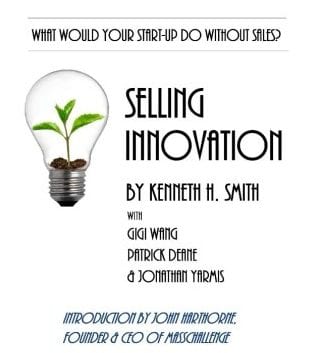 This guest article by Kenneth H. Smith is from his book Selling Innovation: A guide to structuring a complete start-up revenue capture process.
This guest article by Kenneth H. Smith is from his book Selling Innovation: A guide to structuring a complete start-up revenue capture process.
Insight and Innovation
There is a difference between an innovation and an invention. An invention is a new technological breakthrough. An innovation is a better way of doing something, a way to break or disrupt a current paradigm. It can be a technological break-through, a process improvement, or a new object. But no matter how clever, if it sits on the shelf or gets studied by a very small group of people it may be more of an invention than an innovation.
If you are going to become a successful innovator you must first start by identifying a high-value problem, and then build a solution that solves it.
There is no shortage of would-be entrepreneurs who believe they have created a new and unique invention. No one needs a better mousetrap, but everyone needs a better way to solve the problem. If you built the most effective mousetrap in the world but found that sales of cats had virtually eradicated the household mouse problem, what is the value of your innovation?
When you‘re ready to start designing an innovation, you want to think about the larger market, so you can assess its impact in the next larger context than the one you are currently playing in. This is the framework you will need to explain your innovation to others and eventually to sell the innovation in the market. It enables a person reviewing your innovation to evaluate it with some familiar points of reference. It helps your prospective buyer grasp how your innovation will solve their problem.
Understanding the context of your innovation is also important to the future selling process because it is the first indicator of optimal target market, level of receptivity, and frame of reference among potential users. If you create a totally new, different, unique innovation that has never come before there is no frame of reference users can draw upon to make a buy decision. While the iPhone was a disruptive innovation in the mobile phone and software industry it didn’t compare to the disruption caused by the introduction of the telephone into the consumer market in the early 1900’s. Likewise, a Prius is an innovative new type of hybrid vehicle, but it’s still a car that takes you from point A to point B.
As you move from creation to sales, the context in which you created your innovation will be critical to convincing investors, customers, and even prospective employees of the value of the innovation and buy into your vision.
How you sell your product or service will be impacted by the foundation of your innovation. Some products are borne from years of experience in a specific industry that yields a keen insight into a need in the market for a new or better way of doing things. Other products come from blue-sky thinking; from an inspiration into what people might want, use, or enjoy that is radically different from anything they have experienced before.
How do you know when your initial spark is more of an invention or an innovation? When innovations are born from a specific market need, descriptions tend to be value statements that reference the problem being solved. Efforts to sell an invention often focus on descriptions of features and function of the product.
What are the changes in market dynamics that your innovation addresses?

Disruptive vs Incremental Innovation
Truly disruptive innovations do not occur often. For among other reasons, there are only so many adopters in any given market willing to continually try radically new products and services. Disruptive Innovations can only target the much smaller early adopter segment of the population, and it requires its users to accommodate the new information or way of doing things into their daily lives. But while re-shaping the dynamics of a marketplace may seem attractive, many a fortune has been built on incremental innovation.
Incremental innovation is an add-on, value-adder, or after-market creation that has clear application as part of an existing innovation or platform. It is often easier to sell because adopters need only assimilate a marginally new framework of thinking or doing to find value from the innovation.
There is another key aspect to ‘disruptive innovation’ that all innovators need to keep in mind when the spark of innovation is forming in your mind. While an innovation may be disruptive to a particular market or industry, the term disruptive is not a value proposition to most people’s ears. Never before has a user thought their life is too easy and what they really need is to have their safe, familiar patterns of behavior disrupted.
Remember your elementary school days when one kid in the class got sent to the principal’s office because s/he was being ‘disruptive’? Disruptive is not always good. In the example from Harvard Business School professor Clayton Christensen’s the Innovator’s Dilemma, the mini-mills in the steel industry generated great wealth and opportunity for those people who had a vested interest in them. But there were thousands who worked and gained from traditional mills who were thrown out of job, lost value in their stock portfolio, or otherwise did not benefit from the disruption in the marketplace. This is not to say that it should not have happened or that innovation is a bad thing. Rather, especially when selling an innovation into a mature market place, what you are selling may threaten someone else’s job, a way of doing business, or even an entire company. Resistance to buying may have little or nothing to do with your innovation.
Disruptive innovations are also often first to market, but first-mover status seldom translates into sustained sales advantage. Few first movers have been able to capture and sustain market share, even ones that were able to scale. Google was not the first search engine. Facebook was not the first social networking site. The iPod was not the first hand-held audio player. Each evolved from prior iterations of a comparable, but perhaps less sophisticated or less well sold, innovation.
Innovation goes in waves. As markets mature and successful sellers establish dominant position there are myriad opportunities for disruption – a better way of doing business, a faster tool, a bigger device. These moments used to occur only every decade or two. Over the past few decades the cycle has shortened to five or seven years. And technology now allows innovators to bring solutions to market faster, cheaper, and to a larger audience than ever before. But if the goal is to become a successful innovator and not a clever inventor, it may be best to wait until the market has told the innovation community exactly which disruptions its willing to live with, much less buy.
As the waves of disruption evolve, innovators can monitor prior efforts to see how certain products with definable features were adopted by customers, and make refinements to better address a now clearer market need. Eventually, an innovation is layered on top of an existing way of doing business, and integration points emerge among once disparate innovations, which enable new ways of doing things that were once not possible. Social networks, for example, were once an innovation separate from smart phones, and innovations in each market attracted interest from early adopters and venture capital. Now, more pictures are taken using the iPhone and posted to Facebook than using any other photographic device.
Scale is also reached at this point of convergence creating larger commercial opportunities. Incremental innovation becomes easier to identify, quantify, and sell because data exists and can be analyzed to determine the most cost effective path to market, ideal delivery mechanisms, customer service requirements, feature sets, and even price. Remember, innovation is not invention, and as the old saying goes, ‘pioneers die with arrows in their backs, farmers die rich’. Being a ‘fast follower’ rather than a disruptor may not be seen as exciting, but it’s a much more reliable path to success paved by giants of commerce.
Is it innovative to be a fast-follower? Ask Bill Gates, Steve Jobs, or Mark Zuckerberg. Can incremental innovation lead to success? Consider Dell or Tesla Motors.
Who might be upset or disrupted by your innovation?
Platform vs. Product
Often the best solution to a problem in the market is a simple one that aligns a few features with a limited set of requirements. But a single product may not be enough from which to build a sustainable business. A product that does not envision any follow-on or add-on modules other than updates to the core product generally encounters a more limited market and fewer future revenue expansion opportunities.
An innovation that is designed to be a platform enabling other follow-on innovators (internal or external) to create new products and services to deliver value based on that platform has a greater chance of sustained success. Platforms enable value multipliers that even the best sales program cannot match. The most successful path is to plan a platform and launch with one specific product in one specific market segment releasing additional products or enhancements over time that complete the platform vision.
Take the automobile. It disrupted the transportation marketplace back in the early 1900’s. Since then myriad innovators have designed add-on products that are sold as part of the ‘car’ platform. Intermittent windshield wipers were not invented by Chrysler, but are a value-enhancing innovation that came years after the first car rolled off the line and are now standard equipment on every vehicle. Airbags and side impact crumple zones have innovations created in the Volvo lab, but the original designers of the Volvo were not likely to have envisioned these key features at the time of the original invention.
Many innovators want to control every aspect of their creation. Others welcome hackers. The first requires selling your vision, the second allows users to share in the vision creation process. It’s up to each innovator to decide how much control you want to maintain.
What three extensions to your innovation can you imagine now which could be added later by you or someone else?
Minimal Viable Market
Where inventions are products in search of a market, innovations are solutions to a specific and measurable market need. One of the first questions an innovator needs to ask is whether that market need is large enough to recover the investment of time and resources necessary to build and bring the innovation to market. Can the innovation capture enough customers fast enough and cost-effectively enough to pay for ongoing business operations?
In the healthcare industry there are phenomena called orphan diseases. These are maladies that, while sometimes horrible or even fatal, do not afflict enough people to create a sufficiently large and sustainable market for drug companies and medical device innovators to spend the time and resources necessary to finding a proper treatment or cure. At the same time, while some diseases afflict millions, those people do not have the ability to pay for an often simple treatment regimen. Instead, governments, NGOs, and philanthropies step in to fund research and/or distribution of treatments for these orphans.
There are as many ‘orphan’ market opportunities in every industry as there are inventors with great products in search of a market to sell to. Before an innovator spends the time and resources building a minimal viable product, time and resources can be better spent conducting additional detailed market analysis to determine whether the proposed innovation reaches a large enough market with the ability to pay, but one that can be clearly defined. Targeting the 380,000,000 US consumer market or 1,000,000,000 smart phone user’s world-wide is a large enough target market, but it’s not sufficiently specific to determine whether an innovation has a chance of selling successfully.
Niche markets with clearly defined needs that are limited in size are often the best place to focus a new innovation. Start by identifying a specific need with no more than three to five key characteristics that can be easily explained in one sentence or less, design a solution that meets each of those key needs, and have a realistic plan for capturing one or two enterprise or five to ten thousand consumer users. Write that up in a one page summary and you have the genesis of a commercial innovation.
What is the total market penetration of three products different from your innovation but that target the same market?
Aspirin or Vitamin
You don’t need to ask a doctor or nurse whether patients are more likely to take an aspirin (or other pain killer) to take away a headache, or swallow their recommended daily vitamins to stay healthy. Just ask yourself.
Innovations often fall into one of two categories, they either solve a point of pain or make the buyer feel better. As with pain killers or any life-saving drug, people will pay a lot of money to take away the pain, but only under optimal circumstances will they spend money much less continue to buy something that makes them feel better.
What is pain in the innovation economy? In the enterprise marketplace it’s easier to quantify – pain is unnecessary or excessive cost, or unrealized revenue. When a company pays for a product that delivers results less efficiently or more costly than a solution that you have, there’s pain. When a company’s competitors are taking away business and winning key contracts because a feature is missing or a process is broken, there’s pain. Selling a product that addresses these pain points is more likely to yield sales results.
In the consumer market pain can be harder to quantify but is no less important in terms of the selling innovation process. Pain could be too high a price for poor service, a fundamental need such as family security or safety, or a basic need like food. In certain elements of the consumer market pain can also be driven by social factors or ego. As much as we all like to project ourselves as rugged individuals, the crowd has a huge impact on what we spend money on. How many people on your street drive the same or similar cars? Do you own a baby stroller that’s just one model newer than the other mom’s in your book club? Not being part of the in-crowd can be very painful.
Now, no one likes being taken advantage of especially in a sales pitch. But aligning the characteristics of your solution with the specific areas of pain your target market is experiencing is a very effective means for capturing their attention and closing the sale.
What characteristics of your innovation make it a ‘need to have’ for your potential buyers?
 About the Author:
About the Author:
Kenneth H. Smith is the author of Selling Innovation, founder of Rejjee, and a career entrepreneur. He has held senior management roles in seven start-ups in the high tech, clean tech, and consumer products industries. He has served as co-chair of the CEO Services Committee at the MIT Enterprise forum, and has been a guest speaker / lecturer at Harvard University, MIT, Boston College, Boston University, Babson College, UCLA and Berkeley. He has given keynote presentations and participated on expert panels  at major international conferences in San Francisco, Las Vegas, Los Angeles, Boston, London, Glasgow, and Leipzig.
at major international conferences in San Francisco, Las Vegas, Los Angeles, Boston, London, Glasgow, and Leipzig.
He is currently a start-up coach, advisor and business plan reviewer for Springboard Enterprises and has been invited to judge investment pitches from start-ups in New York, London, Boston, and Australia. He is working on three diverse start-ups as founder or senior product manager.
 Ken earned his Master’s in Education with honors (computer-assisted instruction) from Simmons College in Boston, and his Bachelor’s is Industrial Psychology from the University of San Francisco. He lives in Cambridge with his wife Anne Marie, also a successful entrepreneur.
Ken earned his Master’s in Education with honors (computer-assisted instruction) from Simmons College in Boston, and his Bachelor’s is Industrial Psychology from the University of San Francisco. He lives in Cambridge with his wife Anne Marie, also a successful entrepreneur.
